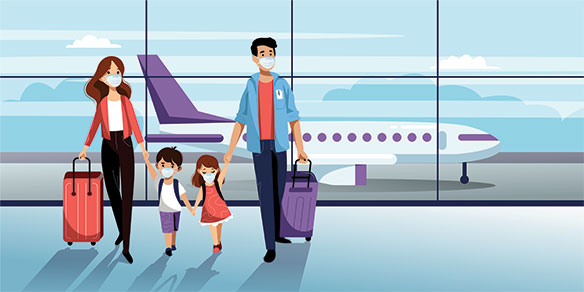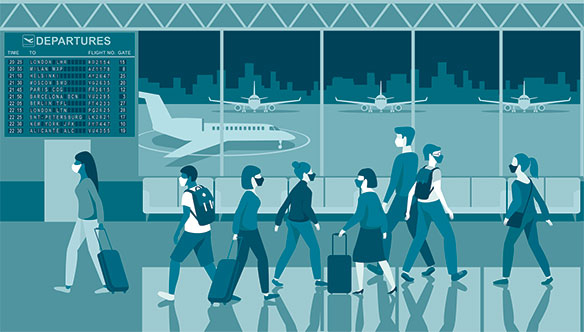
Meet your new competition: The desire not to travel … at all

In conversation with Canadian Travel Press, Forrester’s chief business technology officer & head of FeedbackNow, Steve Peltzman makes it clear that “the pandemic will have a long-term effect, and the customer balance between convenience and safety will shift forever as a result.”
Every sector of the travel and tourism industry wants to get back to business, I’m wondering what’s the first piece of advice you’d offer to the industry right now in terms of where to begin?
Real competition is no longer just other forms of travel and hospitality but rather the desire to not travel at all.

Peltzman
Our research shows about four in 10 US adults feel comfortable stepping into an aircraft, hotel lobby, or restaurant only after the business proves its safety measures are effective.
You need to prove to every traveller you’re not just doing basic cleaning and mask-wearing – you’re fundamentally changing their experience to put them more at ease.
Following up on this, what do you see as the role that technology will play for the travel industry going forward? And how should travel companies/ organizations use technology to adapt to the realities of a world that is still being challenged by an active pandemic?
Contactless solutions, people counting, and other social distancing methods will come to the fore.
That said, adapting and evolving in the pandemic world will require more than relying on emerging technologies; you’ve got to know what experiences to re-design and how to design them, and you must do so with the agility that this quick-changing world demands.
The post-pandemic travel industry can’t afford months to design and roll out complex new experiences.
Technologies that can tell you what travellers are feeling and help you to provide the comfort and control they need the fastest will become the most critical.
And just for the record, do you have a timeline for how this will play out? Will businesses be dealing with in a year … or two years … or five years? Can you give Canadian Travel Press’ readers an idea to help them plan for the future?
No one can really be sure, but given the four phases of the pandemic put forth by Forrester CEO George Colony, we’re currently in the third phase – management. Here, governments are setting protocols and new experiences are emerging in reaction to these.
The final phase, eradication, is predicted to occur in late spring/early summer of 2021 as a vaccine becomes available.
However, regardless of timeline, we firmly believe that the pandemic will have an everlasting effect on customers’ expectations, behaviours, and anxieties.
There are certainly lots of consumer travel intention surveys, tracking studies, etc., etc., coming out pretty much daily, but what I don’t see is intelligence on how the consumer has been changed by the global pandemic? Or has the consumer been changed by the experiences of the past 4 to 6 months?
 The consumer has definitely been changed.
The consumer has definitely been changed.
However, Forrester’s research shows that different segments are affected in different ways, based on what they’ve experienced.
For example, 40% of those with confirmed or suspected COVID-19 cases in their households intend to shop online much more in the future as opposed to only 21% of all US online adults.
Even among those US online adults not directly affected by COVID, 28% are anxious about their finances and 38% are saving more because of looming economic uncertainty.
The pandemic will have a long-term effect, and the customer balance between convenience and safety will shift forever as a result.
As a follow up, what are the main tenets/principles that the travel industry should use to guide the post-COVID-19 evolution of the customer experience?
The first is comfort.
You’ve got to find every opportunity to reduce anxiety and prove you’re providing a safe experience in differentiated, innovative ways.
Next is control.
Fear and anxiety are directly linked to lack of control, so seek out real-time opportunities to give travellers more information and/or more control over their situations.
Last is speed.
Just as software developers converted to agile software development (try, learn, iterate), the travel industry must shift to a model of agile customer experience development and real-time customer experience delivery.
How will that consumer experience be different from their pre-COVID-19 experience?
It will be a more digital, less physical experience, and it will give the consumer more control over their choices. Some of these changes will be subtle, and some more dramatic.
For example, cleaning a facility every three hours and proving such by signing a clipboard will be replaced by digital systems that prove that it was cleaned every 25 people.
Perhaps airlines will offer a simple app notification that the middle seat next to me is now occupied and allow me to move my seat to a more isolated one.
One of the things that Forrester has flagged is ‘in-the-moment’ customer feedback. What is it and why do you see it as essential in terms of helping businesses respond to and remediate issues before they escalate? Can you offer an example of how this would apply to the travel industry?
Surveys are important, but they typically provide sentiment after the experience, and they’re just the answers to the questions you asked, not what the consumers really wanted to tell you.
Real-time customer experience is about embedding low-friction feedback opportunities at every part of the consumer’s journey so they can provide it quickly and easily, at the moment of experience.
Real-time CX is not only about having that data, but more importantly, re-engineering your operations to respond to it in real-time.
 In the travel industry, this might mean engineering a more flexible operation so more agents can be easily redeployed to address a problematic boarding situation unfolding at a gate.
In the travel industry, this might mean engineering a more flexible operation so more agents can be easily redeployed to address a problematic boarding situation unfolding at a gate.
For hotels, it could be giving the guest the ability to press a button to get more towels immediately delivered to the gym.
There are a wide variety of possibilities for the travel industry to embrace real-time CX, but most of them require more than the data; they need operational changes to take advantage of that data.
There has been a long-standing discussion of how consumers buy their travel – online or offline … for those bricks and mortar agencies planning to re-open their locations, what will their customers expect in terms of comfort and control?
Brick and mortar customers will expect companies to go above and beyond to eliminate any areas of friction and reduce contact.
Air Asia’s recent efforts are a good example of how one company recognized that need.
Customers will also want more direct control over their comfort. Solutions like ours that count the number of people in an area and display that information can become an easy way to visibly provide control back to the consumer, giving them the choice to enter or wait, or make it very clear they need to wait without putting that uncomfortable burden on an employee.
Why is choice such an important factor for consumers as they re-acclimate to travel? And how are travel brands taking consumer choice into account as they reopen for business?
Choice is control – and control allays fear. It’s as simple as that. The travel industry has traditionally been lax about providing choice to the consumer but that needs to change.
Note how Amtrak recently expanded its assigned seating and made it easy for the traveller to change via the Amtrak app.
Opportunities to provide choice don’t just occur before the journey begins – they exist throughout the entire journey.
Travel companies need to sense consumer need and provide choice in real-time.
Last question. What’s the one thing that travel businesses need to remember as they reopen their operations?
COVID-19 is not a temporary shock to the system – it’s a permanent event of industry natural selection. Simply adjusting and reacting won’t cut it. Your “factory floor” must be re-engineered to offer information, choice, and service in a completely new way.

